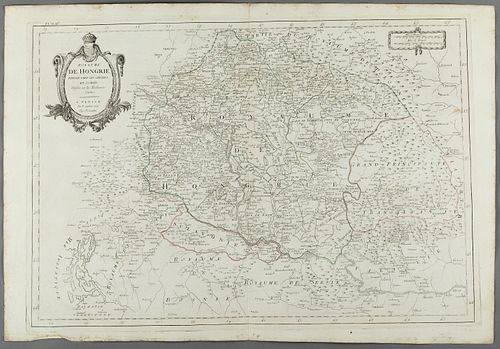"KINGDOM OF HUNGARY", map belonging to the "Atlas Universel, dressé sur les meilleures cartes modernes", second half of the 18th century. Illuminated
Lot 8
About Seller
Setdart Auction House
Carrer Aragó 346
Barcelona
Spain
Setdart Subastas was born in 2004 and is currently the first online art auction in Spain with solidity, prestige and reliability guaranteed by our more than 60,000 users. Setdart has a young, dynamic and enterprising team ready to successfully manage the purchase and sale of art works through custom...Read more
Categories
Estimate:
EUR€300 - EUR€400
$312.50 - $416.67
Absentee vs Live bid
Two ways to bid:
- Leave a max absentee bid and the platform will bid on your behalf up to your maximum bid during the live auction.
- Bid live during the auction and your bids will be submitted real-time to the auctioneer.
Bid Increments
| Price | Bid Increment |
|---|---|
| EUR€0 | EUR€10 |
| EUR€200 | EUR€25 |
| EUR€500 | EUR€50 |
| EUR€1,000 | EUR€100 |
| EUR€3,000 | EUR€200 |
| EUR€5,000 | EUR€500 |
| EUR€10,000 | EUR€1,000 |
| EUR€20,000 | EUR€2,000 |
| EUR€50,000 | EUR€5,000 |
About Auction
By Setdart Auction House
Nov 3, 2021
Set Reminder
2021-11-03 08:00:00
2021-11-03 08:00:00
America/New_York
Bidsquare
Bidsquare : OLD MASTERS
https://www.bidsquare.com/auctions/setdart-auction-house/old-masters-7786
Setdart Auction House sofia@setdart.com
Setdart Auction House sofia@setdart.com
- Lot Description
"KINGDOM OF HUNGARY", map belonging to the "Atlas Universel, dressé sur les meilleures cartes modernes", second half of the 18th century. Illuminated engraving (color demarcations). Edition M. Remondini, Venice, 1784. Hand numbered on verso nº52. According to the numbering stipulated in the index, it should be nº51 IIº (cartes nouvellement ajoutées). The lot is accompanied by a copy of the title page of the atlas. Measurements: 49 x 69 cm (print); 53 x 76 cm (paper). The origin of the "Atlas Universel, dressé sur les meilleures cartes modernes" (Universal Atlas made from the best modern maps) dates back to 1757, when Gilles Robert de Vaugondy (1668-1766) and his son Didier Robert de Vaugondy (1723-1786), geographers to the King of France, formed one of the most renowned map and globe making and manufacturing workshops in France. The excellent position of the Vaugondys in the field of topography, added to the family ties that united them with Nicolas Sanson, one of the most important cartographers of the 17th century, led the Vaugondys to inherit much of the cartographic material that the latter had accumulated over the years, leading to the birth of the ambitious and unique Universal Atlas of which our map is a part. The copy became a commercial and cartographic success with enormous influence in all Europe, reason why the brothers Paolo and Francesco Santini, Venetian engravers, did not let escape the opportunity to acquire the original plates to the Vaugondy. Thus, in 1776, the Santini brothers commissioned the production of new copper plates, while substantially maintaining the original design, keeping the toponyms and the inscriptions in French as defined in the 1757 copy. Due to their knowledge of the Italian territory, the Santini's changes mainly affected the maps of the Italian regions. The following year, Paolo Santini ceded all his publication rights to M. Remondini, who in 1777 and 1784 republished the same Atlas, but with his name. The copy of which our map is part, edited in 1784 by M. Remondini, maintains the exceptionality of the original work of the Vaugondy: the meticulous treatment of the information (based on the revision of the oldest maps available, buying them with the most updated material at the time); the incorporation of the latest academic research in force at the time; the integration of their own astronomical observations (correcting if necessary even the latitude and longitude) or the great decorativism of each of their maps. As in the great majority of cartographic documents produced in France during the 18th century, the map in question is characterized by its enormous pictorial value and great attention to detail. Antique maps are one of the most complete documentary typologies. Their double nature, cartographic and historical, attracts the attention of the most demanding collectors, who see in cartography the faithful reflection of the past, betting on its purchase and its diffusion in the art market. The rarity of some of the editions, added to the longevity of many of the specimens, make the possession and enjoyment of antique cartography an increasingly fashionable pleasure among art lovers. Understood as authentic reminiscences of the past, antique maps become a conscientious reflection of how the territory was divided long ago, or how geographical features define our world. Their decorative character, added to the meticulous and ambitious work of cartographers, turn these pieces into authentic works of art.
- Shipping Info
-
In-house shipping available. Please inquire at admin@setdart.com.
-
- Buyer's Premium



 EUR
EUR CAD
CAD AUD
AUD GBP
GBP MXN
MXN HKD
HKD CNY
CNY MYR
MYR SEK
SEK SGD
SGD CHF
CHF THB
THB














